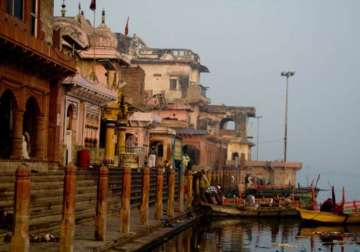Pilgrims visit Mathura on ocassion of 'Adhik Maas'
Mathura/Vrindavan : As millions of pilgrims visit Brij Bhoomi on the auspicious occassion of “Adhik Maas” from June 17 to July 17, questions are being asked how many experts bodies would be good enough to
Mathura/Vrindavan : As millions of pilgrims visit Brij Bhoomi on the auspicious occassion of “Adhik Maas” from June 17 to July 17, questions are being asked how many experts bodies would be good enough to manage developmental activities in Mathura.
Adhik Maas is a month long religious functions. In the Hindu calender, an extra month is added after three years. This year an extra Asaadh has been added and it occurs after 19 years.
While local member of parliament (MP) Hema Malini has her own vision of development, the saints of Braj Mandal, international society for Krishna Consciousness (ISKCON) spiritual leaders and Sadhvi Ritambhara, want the original glory and heritage status to be restored. As of now mosts are opposed to the current trend for speedy development.
”Around 21-member experts committee would be formed to give suggestions for development of Mathura and Vrindavan. He has already announced Rs.120 crore for Mathura's infrastructural development,” said Mahesh Sharma, union minister of state for tourism.
Uttar Pradesh Chief Minister Akhilesh Yadav has already constituted a city level advisory committee for heritage city development. The committee includes all the member of legislative assembly (MLAs), member of parliament (MP), senior officials, representatives of local bodies, GLA university chancellor, Mathura Vrindavan Development Authority vice chairman and secretary, architect Mayank Garg, city anchor Vineet Narain of Braj Foundation, software engineer Ranjeet Singh. This committee will make plans and submit for implementation.
The elected local self government bodies are also busy drawing up their individual plans Mathura, Vrindavan, Govardhan, Sonkh, Gokul and Barsana. Their proposals and detailed project reports (DPRs) are under consideration of various funding bodies.
The uttar pradesh (UP) Awas Vikas Parishad has drawn up a long term development plan for the twin cities. Residential areas are accordingly being segregated and taken up for phased development.
As a part of the Taj Trapezium Zone, the eco-sensitive area of 10,400 sq km around the Taj Mahal, no plan for development can progress without a clearance from the Taj Trapezium Zone Authority that came into existence in 1984 with approval from the parliament after the M.C Mehta PIL on Taj pollution.
”With such a plethora of bodies often at logger heads, how can a coordinated plan for heritage conservation in the Braj area move ahead. This is why, you only see haphazard clusters of mismanagement and inefficiency due to large scale corruption. The Forest department and the UP state pollution control board have a little say in matters relating to urban development,” said Surendra Sharma, president of the Braj Mandal Heritage Conservation Society.
”Instead of creating so many new bodies, filled with too many politicians, the existing nagar palikas, gram panchayats, the zila parishad, and other similar statutory bodies should have been empowered to get the locals involved in the development of their areas. Outsiders can not do justice as they do not have the same vision like locals about Mathura's development,” said BBS members in a memorandum to the district magistrate on Tuesday,” said Braj Bachao Samiti members
